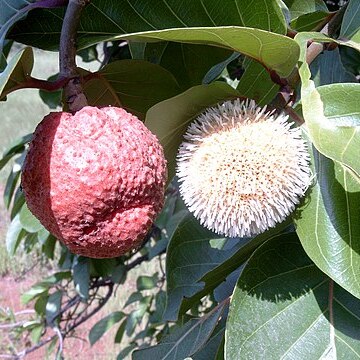Shrub or small tree 2–9 m. tall; branchlets mostly thick, glabrous or minutely puberulous, drooping; bark grey or brown, very fibrous, deeply fissured; slash yellow with crimson streaks.. Leaves dark green and shining above; blade broadly elliptic to rounded-ovate, (8–)10–21 cm. long, (5–)7–14 cm. wide, shortly acuminate at the apex, cuneate to rounded or subcordate at the base, glabrous save for sometimes a fine indumentum on the costa beneath; secondary nerve-axils containing very small pubescent domatia; petiole red or purplish, 0.8–2 cm. long; stipules deltoid, 3–5 mm. long, 1–2-apiculate, glabrous.. Inflorescences solitary, terminal, 4–5 cm. in diameter, fragrant; peduncle short, 1.5–2.5 cm. long.. Calyx-lobes triangular 0.5–1 mm. long, pubescent with deciduous clavate appendages.. Corolla white or yellowish, (0.5–)0.9–1.2 cm. long; tube narrowly funnel-shaped; lobes 4–5, almost round, ± 2–2.5 mm. long, sometimes ciliolate.. Ovary ± distinctly 2-locular or sometimes with the partition imperfect above; style exserted from the corolla for 5–9 mm.; stigma 2.5–4 mm. long, conical with 2 basal swellings, acuminate at the apex.. Syncarps ovoid or globose, red and fleshy, edible, (2–)5–8 cm. in diameter, rugose and pitted with pentagonal scars.. Seeds numerous, superposed in series, subglobose or ellipsoidal, 1–1.2 mm. long, reticulate, the testa-cells each with 5–6 large perforations.. Fig. 60.
More
A small tree or shrub that loses its leaves. It has many stems and grows 2-9 m tall. It can grow a large tree in forest. The trunk is crooked and can be 30 cm across. It can have several stems. The branches are thick and drooping. The bark is dark grey and very fibrous. It is deeply cracked. The leaves are shiny green but darker on top and paler underneath. They are a wide oval shape and 10-21 cm long. The tip is pointed and the base is rounded. The leaves are thick with deep veins. The leaf stalk is red-purple. It is about 2 cm long. The flowers are white-yellow and have a strong smell. They occur in single rounded heads about 4-5 cm across. The flowers are in a rounded "pin cushion" like head. The individual flowers have slender tubes. The flower stalk is 1-2 cm long. The fruit is a compound fruit. It is red or pinkish with a rough appearance and the flesh is deep red and watery. The fruit is pitted like a golf ball. It is a round ball about 5-8 cm across. The surface of the fruit is rough with 5 sided pits. They contain many small seeds. The seeds are very small, about 1 mm across. They lie in the flesh around the solid core. The flesh is edible.
It is a tropical plant. There is a savannah form and a forest form across West Africa. It also grows on ant hills. It grows between 900-1,100 m above sea level. In Ethiopia it grows between 550-1,500 m above sea level. It can grow in arid places.
Plants can be grown from fresh seed. The seeds are very small. To separate the very small seeds from the fruit, mash the fruit then float it in a bucket of water. The seed will separate out and sink to the bottom. They should then be collected and slowly dried. Seed should be planted within 2 months. Plants can be cut back and will re-grow. They can be grown from cuttings or layering.
